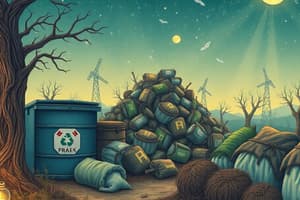Podcast
Questions and Answers
What is the primary goal of waste management?
What is the primary goal of waste management?
- To create innovative waste disposal technologies
- To protect human health and preserve the environment (correct)
- To eliminate all forms of waste
- To maximize the volume of waste produced
Which of the following is considered hazardous waste?
Which of the following is considered hazardous waste?
- Food scraps
- Plastic bottles
- Old newspapers
- Batteries (correct)
What is the correct order of the waste management hierarchy?
What is the correct order of the waste management hierarchy?
- Reduce, Reuse, Recycle, Recovery, Disposal (correct)
- Recycle, Reduce, Reuse, Recovery, Disposal
- Reuse, Disposal, Reduce, Recycle, Recovery
- Disposal, Recovery, Recycle, Reuse, Reduce
Which method of waste management is known to produce harmful emissions?
Which method of waste management is known to produce harmful emissions?
What challenge does population growth present to waste management?
What challenge does population growth present to waste management?
What best practice encourages community involvement in waste management?
What best practice encourages community involvement in waste management?
Which regulation is often overseen by environmental agencies?
Which regulation is often overseen by environmental agencies?
What future trend in waste management emphasizes sustainable practices?
What future trend in waste management emphasizes sustainable practices?
Flashcards are hidden until you start studying
Study Notes
Waste Management Overview
- Definition: The collection, transportation, processing, recycling, and disposal of waste materials.
- Importance: Protects human health, preserves the environment, and conserves resources.
Types of Waste
- Municipal Solid Waste (MSW)
- Household waste, commercial waste, and some industrial waste.
- Hazardous Waste
- Waste that poses substantial or potential threats to public health or the environment (e.g., batteries, chemicals).
- E-waste
- Discarded electronic appliances (e.g., computers, phones) that contain hazardous materials.
- Construction and Demolition Waste
- Waste generated from construction, renovation, or demolition activities.
Waste Management Hierarchy
- Reduce
- Minimizing waste generation at the source.
- Reuse
- Finding new uses for items instead of discarding them.
- Recycle
- Processing materials to create new products, conserving resources.
- Recovery
- Extracting usable materials from waste (e.g., composting, energy recovery).
- Disposal
- Safe disposal methods (e.g., landfilling, incineration) as a last resort.
Waste Management Methods
- Landfilling
- Burying waste in designated sites; potential for pollution and greenhouse gas emissions.
- Incineration
- Burning waste at high temperatures; reduces volume but may release harmful emissions.
- Composting
- Biodegradation of organic waste into nutrient-rich soil amendment.
- Recycling
- Reprocessing materials to create new products; includes collection, sorting, and processing.
Challenges in Waste Management
- Increasing waste generation due to population growth and consumerism.
- Contamination of recyclables reducing recycling efficiency.
- Public awareness and participation in waste reduction efforts.
- Regulation and enforcement of waste management practices.
Best Practices
- Implementing waste separation at the source.
- Encouraging community recycling and composting programs.
- Educating the public on the importance of waste reduction.
- Promoting policies for sustainable product design and packaging.
Regulations and Policies
- Various laws and regulations governing waste management practices at local, national, and international levels.
- Environmental agencies often oversee waste management compliance and guidelines.
Future Trends
- Growing emphasis on circular economy principles.
- Advances in waste-to-energy technologies.
- Increased use of data analytics for waste management optimization.
Waste Management Overview
- Waste management involves the collection, transportation, processing, recycling, and disposal of waste materials.
- Essential for protecting human health, preserving the environment, and conserving natural resources.
Types of Waste
- Municipal Solid Waste (MSW): Comprises household, commercial, and select industrial waste.
- Hazardous Waste: Contains materials that pose significant risks to public health and the environment, such as batteries and chemicals.
- E-waste: Refers to discarded electronic devices (e.g., computers, phones) that often include hazardous components.
- Construction and Demolition Waste: Generated from building, renovating, or demolishing structures.
Waste Management Hierarchy
- Reduce: Focus on minimizing waste generation from the outset.
- Reuse: Seek out new applications for items instead of discarding them.
- Recycle: Process waste materials to create new products, thus conserving resources.
- Recovery: Extract usable materials from waste, including methods like composting and energy recovery.
- Disposal: Implement safe disposal methods, such as landfilling or incineration, as a last option.
Waste Management Methods
- Landfilling: Involves burying waste in designated areas, with risks of pollution and greenhouse gas emissions.
- Incineration: Burns waste at high temperatures to reduce its volume but may emit harmful pollutants.
- Composting: Converts organic waste into nutrient-rich soil amendments through biodegradation.
- Recycling: Involves the reprocessing of materials into new products, encompassing collection, sorting, and processing.
Challenges in Waste Management
- Increase in waste generation is linked to population growth and heightened consumerism.
- Contamination of recyclable materials undermines recycling efficiency.
- Public awareness and participation in reduction initiatives are generally low.
- Effective regulation and enforcement of waste management practices face obstacles.
Best Practices
- Advocate for waste separation at the source to streamline processing.
- Support community recycling and composting initiatives to boost participation.
- Educate the community on the critical nature of reducing waste.
- Encourage compliance with policies promoting sustainable product design and packaging.
Regulations and Policies
- Implementation of various laws governing waste management exists at local, national, and international levels.
- Environmental agencies play key roles in overseeing compliance and establishing guidelines for waste management.
Future Trends
- Increased focus on circular economy principles aims to minimize waste and enhance resource efficiency.
- Innovations in waste-to-energy technologies are emerging as viable options.
- Utilization of data analytics is on the rise for optimizing waste management practices.
Studying That Suits You
Use AI to generate personalized quizzes and flashcards to suit your learning preferences.




